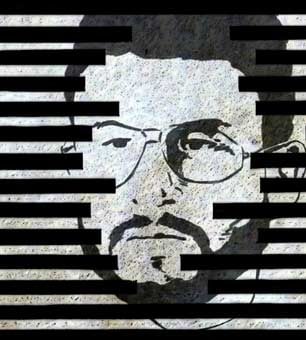The European Court of Human Rights concludes that so-called enhanced interrogation techniques – specifically approved by John Yoo and Jay Bybee for use by the CIA on Abu Zubaydah at a Polish black site – amounted to torture.
When President Obama says the United States “tortured some folks,” perhaps he is referring to Abu Zubaydah. The European Court of Human Rights (ECHR) recently issued a decision concluding that the techniques the CIA used to interrogate Zubaydah “amounted to torture” within the meaning of Article 3 of the Geneva Convention. [1]
The ECHR decision connects the torture perpetrated on Zubaydah with analysis provided in a legal memo dated August 1, 2002, from John Yoo and Jay Bybee to the Central Intelligence Agency’s General Counsel John Rizzo (Interrogation Memo).
Yoo and Bybee drafted the Interrogation Memo and numerous other memos in support of the “war on terror” while they were attorneys at the Office of Legal Counsel in the Department of Justice under President George W. Bush. Although Bybee signed it, Yoo is acknowledged as the principal author of this memo. The Interrogation Memo purports to give legal guidance regarding permissible interrogation techniques for use on a specific detainee, Zubaydah, outside of the United States.
The Capture of Zubaydah Directly Lead to Drafting of Interrogation Memo
Abu Zubaydah was captured from a home in Pakistan around March 27, 2002, and taken to black site in Thailand. Zubaydah remained in Thailand until around December 4, 2002, when he was sent to a black site in Stare Kiejkuty, Poland, where he remained until September 2003.
In early 2002, immediately after the capture of Zubaydah, the CIA asked whether the proposed use of specific enhanced interrogation techniques violated federal law prohibiting torture. According to Yoo’s testimony before a House Judiciary Subcommittee, the Office of Legal Counsel was “asked to evaluate the legality of interrogation methods proposed for use with Zubaydah.” [2] The CIA provided Yoo and Bybee with a list of 10 proposed interrogation methods for review. The list included “walling,” facial slaps, stress positions and waterboarding. [3]
John Yoo and Jay Bybee analyzed the 10 proposed methods. Essentially, the legal analysis in the Interrogation Memo can be summed us as follows:
• Torture requires a “specific intent” to cause prolonged mental harm. [4]
• If an interrogator has a “good-faith belief” that he will not inflict prolonged harm, then there is no specific intent .[5]
• The “good-faith belief” that there will be no prolonged harm is found in statements from psychologist consultants who were paid by the CIA. [6]
The specific analysis of each proposed technique is chilling. According to Yoo and Bybee, it’s OK for the CIA to waterboard Zubaydah because waterboarding doesn’t “inflict actual physical harm” but instead is a “controlled acute episode” and lacks the “protracted period of time” required for “suffering” to violate federal law. [7]
According to Yoo and Bybee, it’s OK to engage in walling – where Zubaydah is “pulled forward and then quickly and firmly pushed into a flexible wall” – because placing a towel around his neck will prevent whiplash. [8]
And so on, through the list of proposed interrogation techniques, finding each one permissible for the CIA to use on Zubaydah outside the United States.
The ECHR “notes that the CIA documents give a precise description of the treatment to which High-Value Detainees were being subjected in custody as a matter of precisely applied and predictable routine, starting from their capture through rendition and reception at the back site, to their interrogations.” [9] Some of these precise routines include the enhanced interrogation techniques discussed in the Interrogation Memo drafted by Yoo and Bybee. For example, the CIA did not waterboard Zubaydah prior to the August 1, 2002. Then, the CIA waterboarded Zubaydah 83 times in the month of August 2002, immediately after the Interrogation Memo was written.
While in Poland, the ECHR concludes, the CIA’s treatment of Zubayah “amounted to torture.” In other words, the precise techniques analyzed and approved by John Yoo and Jay Bybee and used by the CIA in Poland on Zubaydah, amounted to torture.
Notes:
[1] European Court of Human Rights, Husayn (Abu Zubayday) v. Poland, Application number 7511/13, issued on 24 July 2014, (ECHR), pg. 196.
[2] Hearing Before the Subcommittee on the Constitution, Civil Rights, and Civil Liberties of the Committee on the Judiciary, House of Representatives, 110th Congress, 2nd Section, June 26, 2008, Serial No. 110-189, page 13 (page 4 of Yoo’s prepared statement).
[3] ECHR, pgs. 15-16.
[4] Interrogation Memo, pg. 16.
[5] Interrogation Memo, pg. 17.
[6] Interrogation Memo, pg. 18.
[7] Interrogation Memo, pg. 11.
[8] Interrogation Memo, pg. 16.
[9] ECHR, pg. 193.
Join us in defending the truth before it’s too late
The future of independent journalism is uncertain, and the consequences of losing it are too grave to ignore. To ensure Truthout remains safe, strong, and free, we need to raise $43,000 in the next 6 days. Every dollar raised goes directly toward the costs of producing news you can trust.
Please give what you can — because by supporting us with a tax-deductible donation, you’re not just preserving a source of news, you’re helping to safeguard what’s left of our democracy.
